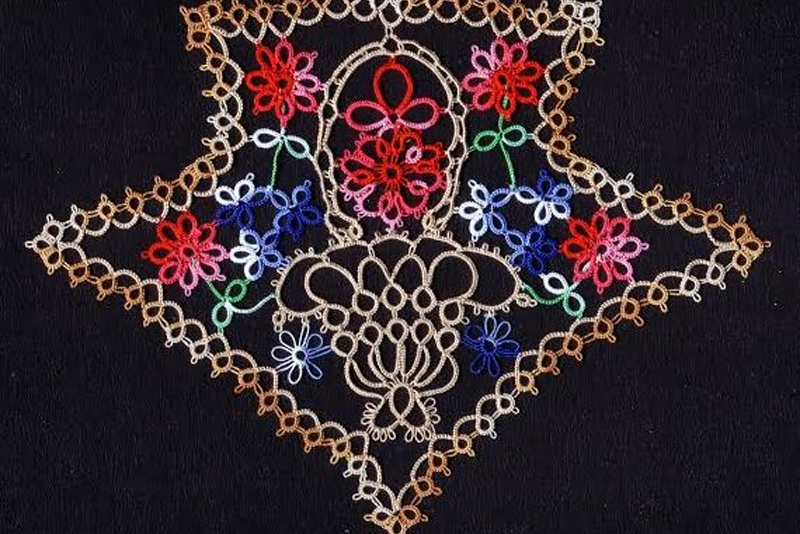I recently reported in the BellaOnline.com tatting newsletter about an 1885 guide for young ladies. I read the frontispiece where it lists all the art and crafts it contained. There was Berlin work, crochet, drawn-thread work, embroidery, knitting, knotting or macramé, lace, netting, Poonah painting and finally, tatting. I actually turned to the section on Poonah painting first as the term was new to me. I read through the pages and found that it means stenciling! I think the term we use today may be theorem stenciling.
I offered comments on illustrations #13 and #15 which I found puzzling. As I studied further I read through pattern #21 and compared it to the illustration on page 104 of the guide. The pattern is tatted with only one shuttle. Instead of the familiar round center ring which could be used to climb out into the second round, this has a set of four outward facing rings. Originally the tatter was to cut the thread and tie on again or bring the shuttle thread to the back of the work and secure it to a picot and move into the second round. This method, of course, the leaves the shuttle thread visible and somewhat unsightly.
This is a perfect sample to modernize! But how to climb out? Only one shuttle, can't do a split ring. Or can we? Why, yes, we can! We could do a single shuttle split ring a la Dora Young. This uses the core thread on the wrapped side of the split ring as if one were covering a split chain. The ring is tatted half way to the climb out spot, then half closed leaving a length of thread that is bare and equal to the length needed to match the tatted side of the ring. Not always symmetrical. Double stitches (DS) are then wrapped (not tatted as the flip or transfer does not take place) over the bare thread and the climb out is accomplished.
Or, we can use the loop tail ring method which I learned from Matthew Takeda. Here the first part of the ring is tatted normally up to the climb out spot. Then we pull out enough thread from the shuttle to make a large loop. Holding the bend of the loop, we use it as if it were a shuttle and tat the remaining ds needed. When done pulling one side of the loop will close the ring. Now if the shuttle starts moving, stop and pull on the other side. Next pull the loop over the ring and shuttle both to the opposite side. Remove slack and the ring is done leaving the shuttle thread at the top of the ring in perfect position to climb out.
Pattern #21 with original pattern (mistakes and all)

Begin the square in the center, and work the four leaves, each consisting of ten double knots, one picot, 10 double knots. Fasten the thread, and loop it again on to the picot of a leaf, and work the eye, consisting of seven double knots, five picots separated by 3 double knots, seven double knots; draw them together, fasten the thread again to the picot at the starting-point; then work the large scallop lying to the left; eight double knots, five picots separated by 3 double knots, eight double knots. Leave the scallops sufficiently open, so that after the thread is fastened to the next leaf of the middle group the thread lying across may be tight without dragging. Repeat.

Modern tatting notation
Begin with one shuttle in the center.
R 10 - 3 - 3 - 10 close ring (clr) do not reverse work (DNRW), leave no bare thread space (BTS).
Repeat twice more.
Loop-tail ring or single shuttle split ring to climb out.
R 10/ 3 - 3 - 10 climb out
Outer row
R 7 - 3 - 3 - 3 - 3 - 7 clr dnrw.
Bring thread to the next picot and join.
R 8 - 3 - 3 - 3 - 3 - 8 partially close ring dnrw.
Bring thread to the next picot on next center ring and join.
Repeat around.
Note: if you added a helping loop (magic thread trick) to the climb out ring of the center, you can hide the tail in that ring.
Suggestion: Instead of a shuttle lock join to the picot of the center rings, try a lark's head picot join!
Here's the latest article from the Tatting site at BellaOnline.com.
Tatting Lace Korean Language
This new book from Korea is the second ever Korean language tatting book I have seen. Its emphasis is on tatting for utilitarian or household purposes.
http://www.bellaonline.com/articles/art183402.asp
Please visit tatting.bellaonline.com for even more great content about Tatting.
To participate in free, fun online discussions, this site has a community forum all about Tatting located here -
http://forums.bellaonline.com/ubbthreads.php?ubb=postlist&Board=39
I hope to hear from you sometime soon, either in the forum or in response to this email message. I thrive on your feedback!
Have fun passing this message along to family and friends, because we all love free knowledge!
Georgia Seitz, Tatting Editor
http://tatting.bellaonline.com
One of hundreds of sites at BellaOnline.com







